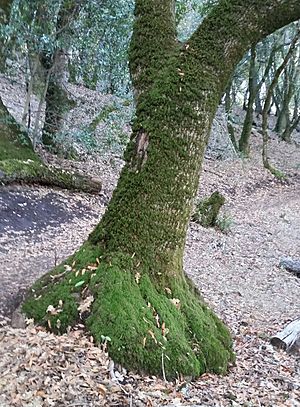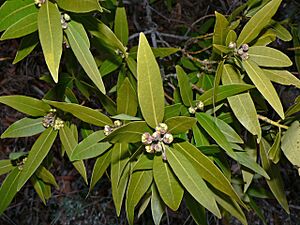Umbellularia facts for kids
Quick facts for kids Umbellularia |
|
|---|---|
 |
|
| Foliage and flowers | |
| Scientific classification | |
| Genus: |
Umbellularia
|
| Species: |
californica
|
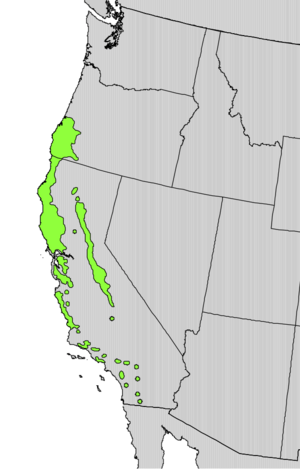 |
|
| Natural range | |
| Synonyms | |
|
Sciadiodaphne Rchb. |
|
The Umbellularia californica is a big, strong tree that grows in the coastal forests and Sierra foothills of California. It also grows in coastal forests that stretch into Oregon. This tree is special because it's the only type of tree in its group, called Umbellularia.
People have many names for this tree. In Oregon, it's often called Oregon myrtle. In California, it's known as California bay laurel, or just California bay or California laurel. Other names include pepperwood, spicebush, and even headache tree because of its strong smell.
The leaves of this tree have a very strong smell and taste, similar to regular bay leaves used in cooking, but even stronger. The wood of the tree can be light like maple or dark like walnut. It's known as a great tonewood, which means it's good for making musical instruments like guitars. Woodworkers also love it.
This tree can also host a germ that causes a plant disease called sudden oak death.
Contents
Where the California Bay Laurel Lives
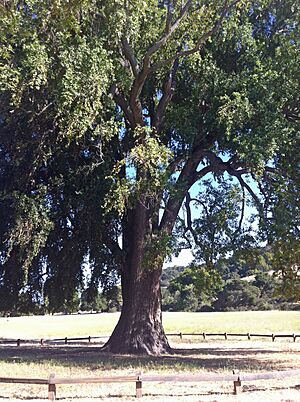
This tree mostly lives in redwood forests, mixed evergreen forests, yellow pine forests, and oak woodlands. You can often find California bay laurel trees near streams or other wet areas, especially in northern California and close to the coast.
Where You Can Find It
You can find the California bay laurel from southwest Oregon, all the way south through California to San Diego County. It also grows in the western foothills of the Sierra Nevada mountains. These trees can grow from sea level up to about 5,250 feet (1,600 meters) high. There are even a few trees growing far north in Tacoma, Washington, and a couple in coastal British Columbia, Canada.
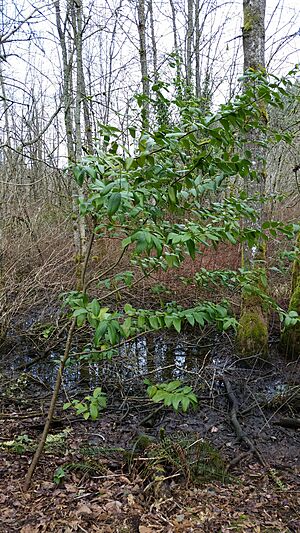
What the California Bay Laurel Looks Like
The California bay laurel is an evergreen tree, meaning it keeps its leaves all year round. It can grow up to 100 feet (30 meters) tall, with a trunk as thick as 31 inches (80 cm). The tallest recorded tree was 108 feet (33 meters) high and 119 feet (36 meters) wide!
Its leaves are very fragrant. They are smooth, spear-shaped, and about 1 to 4 inches (3–10 cm) long. They look similar to regular bay laurel leaves but are usually narrower.
The flowers are small and yellow-green. They grow in small clusters called umbels, which is where the tree gets its scientific name, Umbellularia. Unlike some other "bay laurels," this tree has "perfect flowers," meaning each flower has both male and female parts.
The fruit of the California bay laurel is also called a "California bay nut." It's a round, green berry about 1 inch (2–2.5 cm) long. It has light yellow spots and turns purple when it's ripe. Inside, it has a thin, leathery skin, a soft, oily layer, and a single hard pit. It looks a bit like a tiny avocado. The fruit usually ripens around October or November.
How People Use the California Bay Laurel
Historical Uses
Native American tribes, like the Cahuilla, Chumash, Ohlone, and Miwok, have used the California bay laurel for a very long time.
- Medicine: People used to make a paste (called a poultice) from the leaves to help with muscle aches and nerve pain. They also made a tea from the leaves to treat stomach aches, colds, and sore throats. Some tribes would put a single leaf in a nostril or wash their head with a leaf mixture to help with headaches.
- Food: Both the soft outer part and the hard inner nut of the fruit were eaten. The fresh, soft outer part of the fruit is only good to eat for a short time when it's ripe. Native Americans would dry the fruits in the sun and eat the less strong-tasting bottom part.
- Roasted Nuts: The hard inner seed was often roasted until it turned a dark brown. This made it less strong and gave it a spicy flavor. Roasted "bay nuts" were eaten whole or ground into a powder. This powder could be made into a drink that tasted like unsweetened chocolate. Some people say the nuts might have a stimulating effect, like coffee.
Modern Uses
Today, people still use the California bay laurel in many ways.
- Cooking: The leaves can be used in cooking, but remember they are much spicier than regular bay leaves, so you only need a small amount! They add a strong camphor or cinnamon flavor.
- Food for Foragers: Some modern-day foragers (people who find their own wild food) enjoy preparing the roasted bay nuts, just like Native Americans did.
- Woodworking: The wood is very hard and fine. It's used to make the backs and sides of acoustic guitars because it's a great tonewood. It's also made into bowls, spoons, and other small items, often sold as "myrtlewood."
- Gardening: The tree is also grown as an ornamental tree in gardens, both where it naturally grows and in places like Vancouver in Canada and western Europe. It's sometimes used for firewood too.
- Pest Control: An old Miwok recipe suggests adding California laurel leaves when storing acorns to keep insects away. People also put the leaves between bed mattresses to get rid of fleas.
- Furniture: The wood is also used to make furniture, especially pieces with beautiful patterns.
"Myrtlewood" Money
Did you know that "myrtlewood" was once used to make real money? In 1933, a bank in North Bend, Oregon, had to close for a short time. This caused a problem for the city because they didn't have enough cash. So, the city decided to print its own money using myrtlewood discs! These "coins" came in values from 25 cents to $10. The city used them to pay its workers and promised to exchange them for regular cash later.
However, when the bank reopened, many people decided to keep their myrtlewood tokens as collector's items instead of trading them in. The city eventually said that these tokens would always be legal money in North Bend. Because they are rare and have a cool history, these unredeemed myrtlewood tokens are now very valuable!
Sudden Oak Death
The California bay laurel tree can carry a germ called Phytophthora ramorum. This germ causes a serious disease called sudden oak death. The California bay laurel is important in spreading this disease because it's one of the main trees where the germ easily makes its spores (tiny parts that spread the disease).
Gallery
-
This single Umbellularia lignotuber in Doyle Community Park supports multiple mature sprouts.
See also
 In Spanish: Umbellularia para niños
In Spanish: Umbellularia para niños


